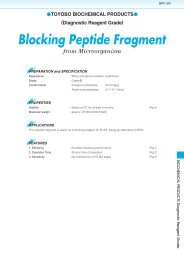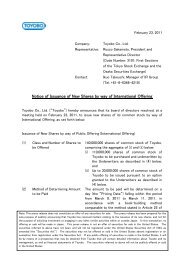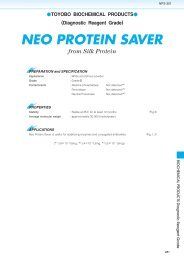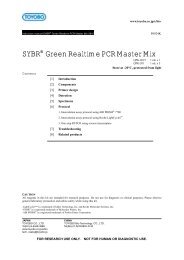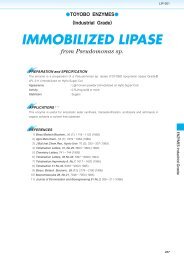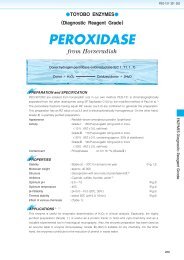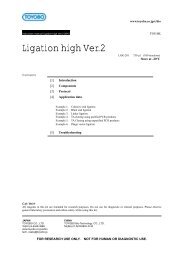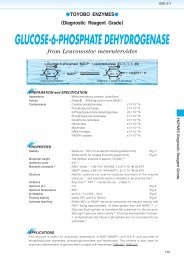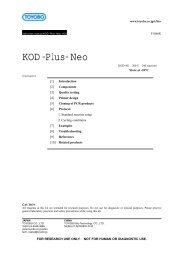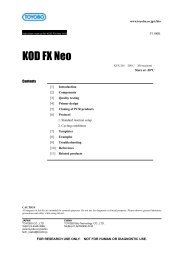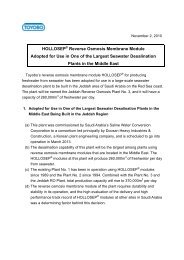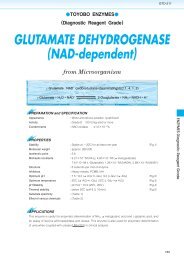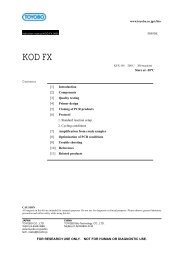CREATININE DEIMINASE - Toyobo
CREATININE DEIMINASE - Toyobo
CREATININE DEIMINASE - Toyobo
Create successful ePaper yourself
Turn your PDF publications into a flip-book with our unique Google optimized e-Paper software.
CNI-311<br />
TOYOBO ENZYMES<br />
(Diagnostic Reagent Grade)<br />
<strong>CREATININE</strong> <strong>DEIMINASE</strong><br />
from Microorganism<br />
Creatinine iminohydrolase (EC 3.5.4.21) 15)<br />
O<br />
HN<br />
H 2 O<br />
HN N CH 3<br />
Creatinine<br />
O<br />
HN<br />
<br />
NH 4<br />
O N CH 3<br />
N-Methylhydantoin<br />
PREPARATION and SPECIFICATION<br />
Appearance<br />
: White amorphous powder, lyophilized<br />
Activity<br />
: Grade10U/mg-solid or more<br />
(containing approx. 30% of stabilizer)<br />
Contaminants : Creatinine amidohydrolase ≤1.010 2 %<br />
Creatine amidinohydrolase ≤1.010 2 %<br />
Urease ≤1.010 2 %<br />
NADH oxidase ≤1.010 2 %<br />
<br />
NH 4 ≤1.010 2 g/u<br />
Stabilizer<br />
: Mannitol<br />
PROPERTIES<br />
Stability : Stable at 20 for at least one year Fig.1<br />
Molecular weight : approx. 260,000<br />
Isoelectric point : 4.4<br />
Michaelis constant<br />
: 3.510 3 M (Creatinine)<br />
Structure<br />
: 6 subunits per mol of enzyme<br />
Inhibitors<br />
: Ag ,Hg , o-phenanthroline,monoiodoacetate<br />
Optimum pH : 8.59.5 Fig.2<br />
Optimum temperature : 6575 Fig.3<br />
pH Stability : pH 7.011.0 (30, 20hr) Fig.4<br />
Thermal stability : below 65 (pH 7.5, 1hr) Fig.5<br />
Effect of various chemicals : (Table 1)<br />
APPLICATIONS<br />
This enzyme is useful for enzymatic determination of creatinine when coupled with glutamate<br />
dehydrogenase (GTD-211, GTD-209, GTD-309) in clinical analysis.<br />
77
CNI-311<br />
ASSAY<br />
Principle:<br />
CreatinineH 2 OH <br />
creatinine deiminase<br />
NH 4 -KetoglutarateNADPH<br />
GIDH<br />
N-MethylhydantoinNH 4<br />
<br />
GlutamateH 2 ONADP <br />
GIDH:Glutamate dehydrogenase(NADP dependent)L-Glutamate:NADP oxidoreductase (deaminating),<br />
(EC 1.4.1.4.)<br />
The disappearance of NADPH is measured at 340nm by spectrophotometry.<br />
Unit definition:<br />
One unit causes the formation of one micromole of ammonia (the oxidation of micromole of NADPH) per minute under<br />
the conditions described below.<br />
Method:<br />
Reagents<br />
A. Creatinine solution 50mM (565.5mg creatinine/100ml of 50mM K-phosphate buffer, pH7.5)<br />
B. NADPH solution 3.0mM (27.2mg NADPHNa 4 4H 2 O/10ml of 50mM K-phosphate buffer, pH<br />
7.5)(Should be prepared fresh)<br />
C. -Ketoglutarate solution 10mM (14.6mg -Ketoglutaric acid/10ml of 50mM K-phosphate buffer, pH<br />
7.5)(Should be prepared fresh)<br />
D. GIDH solution<br />
ca.1,000U/mlDilute <strong>Toyobo</strong> Grade (Tris-HCl buffer solution, free from ammonia<br />
to ca.1,000U/ml with H 2 O.)<br />
E. Enzyme diluent 50mM K-phosphate buffer, pH 7.5<br />
Procedure<br />
1. Prepare the following reaction mixture in a cuvette (d1.0cm)<br />
Concentration in assay mixture<br />
and equilibrate at 37 for about 5 minutes.<br />
K-Phosphate buffer 49 mM<br />
2.4 ml Substrate solution (A) Creatinine<br />
38 mM<br />
0.3 ml NADPH solution (B) -Ketoglutarate<br />
0.95mM<br />
NADPH<br />
0.3 ml -Ketoglutarate solution (C)<br />
0.29mM<br />
GIDH<br />
ca.16 u/ml<br />
0.05ml GIDH solution (D)<br />
2. Add 0.10ml of the enzyme solution and mix by gentle inversion.<br />
3. Record the decrease in optical density at 340nm against water for 34 minutes in a spectrophotometer<br />
thermostated at 37, and calculate the OD per minute from the initial linear portion of the curve (OD<br />
test).<br />
At the same time, measure the blank rate by using the same method as the test except that the enzyme<br />
diluent is added instead of the enzyme solution (OD blank).<br />
<br />
Dissolve the enzyme preparation in ice-cold enzyme diluent (E) and dilute to 0.150.4U/ml with the same<br />
buffer, immediately before assay.<br />
Calculation<br />
Activity can be calculated by using the following formula<br />
Volume activity (U/ml) <br />
OD/min (OD testOD blank)Vtdf<br />
6.221.0Vs<br />
Weight activity (U/mg)(U/ml)1/C<br />
Vt Total volume (3.15ml)<br />
Vs Sample volume (0.10ml)<br />
6.22 Millimolar extinction coefficient of NADH (F/micromole)<br />
1.0 Light path length (cm)<br />
df Dilution factor<br />
C Enzyme concentration in dissolution (c mg/ml)<br />
OD/min5.06df<br />
REFERENCES<br />
1) J.Szulmajster; Biochim.Biophys.Acta, 30, 154 (1958).<br />
2) T.Uwajima and O.Terada; Agr.Biol.Chem., 40, 1055 (1976).<br />
3) T.Uwajima and O.Terada; Agr.Biol.Chem., 41, 339 (1977).<br />
4) D.Tsuru; Rinsho Kensa, 22, 1331 (1978).<br />
5) T.W.Esders and S.Y.Lynn; J.Biol.Chem., 260, 3915 (1985).<br />
78
CNI-311<br />
Table 1. Effect of Various Chemicals on Creatinine deiminase<br />
The enzyme dissolved in 50mM Tris-HCl buffer, pH 7.5 (2U/ml) was incubated at 25 for 2hr with each<br />
chemical. The residual activity was assayed according to the routine method described above.<br />
Chemical<br />
None<br />
Metal salt<br />
MgCl 2<br />
CaCl 2<br />
Ba(OAc) 2<br />
FeCl 3<br />
CoCl 2<br />
MnCl 2<br />
ZnSO 4<br />
Cd(OAc) 2<br />
NiCl 2<br />
CuSO 4<br />
Pb(OAc) 2<br />
AgNO 3<br />
HgCl 2<br />
2-Mercaptoethanol<br />
PCMB<br />
Residual<br />
Concn.(mM)<br />
activity<br />
100%<br />
1.0<br />
1.0<br />
0.1<br />
103.8<br />
100.6<br />
105.7<br />
5.0<br />
108.2<br />
179.0<br />
100.0<br />
143.0<br />
103.2<br />
2.1<br />
87.3<br />
1.1<br />
1.6<br />
96.8<br />
91.1<br />
Chemical<br />
MIA<br />
NEM<br />
IAA<br />
Hydroxylamine<br />
EDTA<br />
o-Phenanthroline<br />
,-Dipyridyl<br />
Borate<br />
NaF<br />
NaN 3<br />
TritonX-100<br />
Brij 35<br />
Span 20<br />
Na-Cholate<br />
SDS<br />
DAC<br />
Concn.(mM)<br />
1.0<br />
1.0<br />
1.0<br />
1.0<br />
2.0<br />
1.0<br />
0.1<br />
5.0<br />
1.0<br />
1.0<br />
1.0%<br />
0.1%<br />
0.5%<br />
0.5%<br />
0.5%<br />
0.5%<br />
Residual<br />
activity<br />
0.6<br />
86.1<br />
60.1<br />
86.1<br />
96.2<br />
0.7<br />
100.6<br />
98.7<br />
100.6<br />
99.4<br />
95.6<br />
83.5<br />
103.2<br />
100.0<br />
101.0<br />
81.8<br />
Ac, CH 3 CO; PCMB, p-Chloromercuribenzoate; MIA, Monoiodoacetate; NEM, N-Ethylmaleimide; IAA, Iodoacetamide;<br />
EDTA, Ethylenediaminetetraacetate; SDS, Sodium dodecyl sulfate; DAC, Dimethyl-benzylalkyl-ammonium-chloride.<br />
100<br />
100<br />
100<br />
Residual Activity,%<br />
50<br />
-20<br />
4<br />
30<br />
27<br />
Relative Activity<br />
50<br />
Residual Activity,%<br />
50<br />
0 1 2 3 4 5 6 12<br />
0 6 7 8 9 10<br />
Period (months)<br />
pH<br />
0 4 5 6 7 8 9 10 11 12<br />
pH<br />
Fig.1. Stability (Powder form)<br />
kept under dry conditions<br />
Fig.2. pH-Activity<br />
37in Britton-Robinson buffer; The<br />
activity was assayed by the indophenol<br />
method. 3)<br />
Fig.4. pH-Stability<br />
3020hr-treatment with Britton-Robinson<br />
buffer<br />
100<br />
100<br />
Relative Activity<br />
50<br />
Residual Activity,%<br />
50<br />
0 30 40 50 60 70 80 90<br />
0 40 50 60 70 80<br />
Temperature, <br />
Temperature, <br />
Fig.3.Temperature activity<br />
Fig.5. Thermal stability<br />
in 50mM K-phosphate buffer, pH 7.5; The<br />
acitivity was assayed by the indophenol<br />
method. 3)<br />
1hr-treatment with 50mM K-phosphate<br />
buffer, pH7.5<br />
79
CNI-311<br />
<br />
<br />
2 creatinine deiminase<br />
<br />
4<br />
GIDH<br />
4 <br />
2 <br />
<br />
<br />
<br />
<br />
<br />
<br />
<br />
P<br />
<br />
4 <br />
2 <br />
P<br />
<br />
P<br />
<br />
<br />
<br />
P<br />
<br />
<br />
<br />
P<br />
<br />
<br />
<br />
<br />
P <br />
P <br />
P <br />
P <br />
P<br />
<br />
<br />
<br />
<br />
P<br />
<br />
<br />
<br />
P<br />
P<br />
P <br />
<br />
P <br />
<br />
<br />
<br />
P<br />
80



